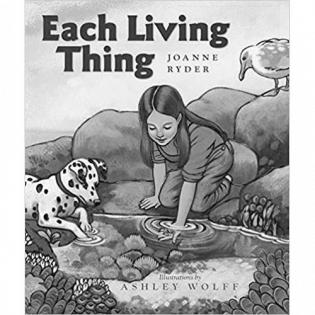Each Living Thing Literature Guide
In today’s world, it’s often easy to be so busy rushing about that we forget to pause and appreciate all the living things around us. Spiders and bugs can seem like pests. Bears and raccoons can seem like nothing more than a nuisance. And anthills take on as much significance as their size as we plow through our everyday tasks. This book challenges us to notice all of the living things around us and to appreciate and care for them. Childhood is a wonderful time to instill a caring attitude in children, and reading this book is a good first step. Will you take up the challenge to “Be aware of them…Take care of them…and…let them be”?
Before Reading
ASK: What does it mean to say something is living? Look up the word living in the dictionary and think of some things that are living.
SHOW: Look at the front and back covers of the book. Name all the living things that you see.
CONNECT: What living things do you see around you every day? Are there living things in your home, at school, and in your neighborhood?
During Reading
ASK: What do you notice about how the book asks us to appreciate living things? Which of the five senses does the book want us to use: sight, hearing, smell, taste, or touch?
SHOW: Look at all the illustrations in the book? What do you notice about the distance between the people and the living things? Are they close together or far apart? What does this tell you about what the author wants us to know?
CONNECT: What are some ways you can admire nature but “let it be” as the book says?
After Reading
ASK: The last page of the book asks us to be watchful. What do you think the author means? You may want to look up the word "watchful" in a dictionary.
SHOW: Look at each picture in the book. How are the people on these pages being watchful?
CONNECT: How can you be watchful in your own neighborhood? What living things are there that you can observe? What new things could you find out by being watchful?
Activities
- Keep track of all the living things you see for a week. Create a chart with headings for Insects, Birds, Mammals, Reptiles, Amphibians, and Fish. Write each animal you see in the correct column. At the end of the week, sit down and look at your list. Which kind of animal did you see most? How many animals are so tiny you might accidentally step on them? How many are bigger than you are?
- Pick your favorite page spread from the book. Find out how the animal you see on those pages is helpful to humans. For example, bees pollinate flowers, even though they sometimes sting when disturbed.
- Imagine what the world would be like without animals. Draw a picture or write a short story or poem to show what you think the world would be like. What animals would you miss the most, and why. What animals do people depend on for food? For companionship? For conditioning the soil and recycling wastes?
[Activity idea courtesy ASPCA] - Create a wildlife collage. Cut out photographs of wild animals from magazines. Focus on American wildlife such as coyotes and eagles. Then draw or cut out various wildlife habitats such as forests, beaches, prairies, deserts, or mountains. Sort their pictures by habitat, and then glue each animal onto his proper environment. Finally, label each collage with the name of the habitat and list the animals that live there.
[Activity idea courtesy ASPCA] - Subscribe to Your Big Backyard magazine, and every month you’ll be able to learn more about your backyard wildlife and wildlife from around the world. To subscribe, go to the Kids & Families section of the National Wildlife Federation website.
- Read “Hey, Little Ant”. Compare and contrast these two stories.
